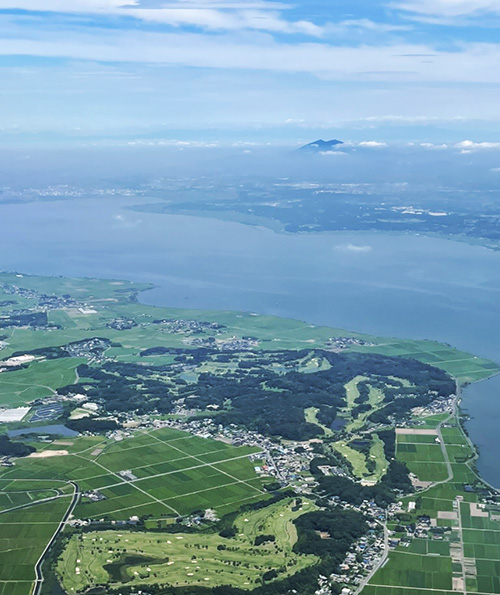
ここ数日の札幌は朝の内は22-23度程度の気温で推移して、ようやく北海道らしい夏の様相に落ち着いてきた感じでありましたが、昨日わたしは毎朝の散歩の日課を時間短めで果たしたあと、千歳から東京へ移動いたしました。
到着後すぐは「お、ムッとくるなぁ」という湿度たっぷりの重たい空気感が迎えてくれましたが、一応東京暮らし前後8年ほどの体験があるので、すぐにカラダは適合を始めてくれる。諦めのいい性格の身体であります。みなさんこの環境の中で生活していられるのですから、エトランゼとしても礼儀正しくしている一択であります。ちなみに東京の昨日の気温は37.7-25.6度ということ。札幌の最高気温は28.9度なので9度近い温度差。
で、仕事日でさっそく3軒ほどの訪問先を片付けたのですが、どちらも程度の差こそあれ、ガンガン冷房空調をされているので、ところによっては肌寒いほど。
しかしまぁ、表題のような発言が出ると言うことは、地球温暖化の現実は相当のレベルで現在進行形なのだろうと思います。こういった猛暑気候が続くことでまず第一に不安なのは、農業生産への影響なのではないかと思われます。空からの眺めでは田畑の様子は順調な生育ではないかと思われますが、予断は許されないでしょうね。なんでもコメの価格が上昇という注意信号。
これは海外からのインバウンド観光が完全に復活してきて、コロナ前の入り込み水準に戻って来たことで結果として国内需給の逼迫と言う現実があるとのこと。そういった市場要因であれば対応はいずれ可能でしょうから慌てることはないでしょう。しかし、数十年に一度しか咲かない草花が花開いたという報道もあったように、自然は確実に温暖化反応が進行している。
日本史でも気候の温暖ー寒冷は周期的に繰り返されて、そういった変動を乗り越えながら日本民族は生き長らえてきている。変動からの経験知を活かしていく必要があるのでしょう。北海道の農業という意味では決してマイナス要因とも言えない。こうした環境変動をプラス思考で乗り切っていくことも可能性はあるでしょう。
一方で漁業資源ではこれまでとは捕獲される魚種が大きく様変わりしてきていると。最近市場に行くと大物の「ブリ」が目を奪われるほどの低価格で出回っている。50cm超の大物が2,000円程度で出ている。握り寿司愛好家としては、おいおいブリかよと目を輝かせているのですが、捌いたら寿司ネタとしてはたぶん200-300カン以上、ひょっとすると500カンくらいになるかも知れないと思うと、家庭の冷凍庫に保存可能なレベルを超えてしまう。まさかブリばっかり寿司握りするわけにも行かないし。・・・
しかし、今後ともこうした傾向が長期化するとすれば、そういう自然の恵みの変動に対応した料理を考えて行くべきなのでしょうね。う〜む。あ、いまは東京に居るのだった(笑)。本日からはライフワークの取材活動。頑張るぞと。
English version⬇
UN Secretary-General says “Earth is a hot and dangerous place.
Hokkaido has a maximum temperature of 28 degrees Celsius, while Tokyo is over 37 degrees Celsius. Everyone seems to be adapting to the situation, although they are feeling a bit “yare-yare” about it. We have no choice but to think positively. …….
The temperature in Sapporo over the past few days has been around 22-23 degrees Celsius in the morning, finally settling into the summer-like atmosphere of Hokkaido.
Upon arrival, I was greeted by a heavy, humid air that made me feel a bit queasy, but I have lived in Tokyo for about eight years, so my body immediately began to adapt itself. It is a body that has a good disposition to give up. Since everyone is able to live in this environment, as an étrancée, I have no choice but to be courteous. By the way, yesterday’s temperature in Tokyo was 37.7-25.6 degrees Celsius. The maximum temperature in Sapporo is 28.9 degrees Celsius, so a temperature difference of almost 9 degrees Celsius.
I visited three places on my working day, and both places were air-conditioned to varying degrees, so it was chilly in some places.
However, the fact that such a statement as the above is made suggests that the reality of global warming is ongoing at a considerable level. The first and foremost concern about the continuation of such a hot and humid climate is the impact on agricultural production. The view from the sky suggests that the fields are growing well, but we must not be too optimistic. A warning signal that the price of rice is rising for everything.
This is due to the reality that inbound tourism from overseas has fully recovered and returned to pre-Corona levels of inflow, resulting in a tight domestic supply-demand balance. If this is a market factor, there is no need to panic, as it will eventually be addressed. However, as reported in the news that flowers that bloom only once every few decades have blossomed, nature is definitely responding to global warming.
In Japanese history, climatic cycles of warming and cooling have been repeated periodically, and the Japanese people have survived and thrived through such fluctuations. It is necessary to make use of empirical knowledge from these fluctuations. In terms of agriculture in Hokkaido, it is not a negative factor. It is possible to overcome these environmental changes with positive thinking.
On the other hand, I have heard that the species of fish caught in the fishery resources have changed drastically from the past. Recently, when I go to the market, large “yellowtail” are being sold at eye-poppingly low prices; a large fish over 50 cm in length can be found for around 2,000 yen. As a nigirizushi (hand-rolled sushi) enthusiast, my eyes are glued to the yellowtail, but when I think of the 200-300 kan or even 500 kan it would make as sushi material, it is beyond the level that can be stored in the freezer at home. I can’t make sushi only with yellowtail. I can’t afford to eat only yellowtail.
But if this trend continues for a long period of time, we should probably think about how to cook in response to such fluctuations in nature’s bounty. Hmmm. Oh, I am in Tokyo now (laughs). Today I will start my life’s work as a journalist. I will do my best.
Posted on 7月 27th, 2024 by 三木 奎吾
Filed under: 日本社会・文化研究







コメントを投稿
「※誹謗中傷や、悪意のある書き込み、営利目的などのコメントを防ぐために、投稿された全てのコメントは一時的に保留されますのでご了承ください。」
You must be logged in to post a comment.